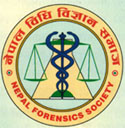NEPAL FORENSIC SOCIETY
Registered under the Nepal Law, Reg.No.622/053-54
|
|
JUSTICE BY FORENSIC SCIENCE
|
Source: Photographer: Kieth Mancini
Forensic Photography The forensic photography section supports the forensic science, toxicology and medical examiner's departments by documenting evidence, crime scenes, and autopsies. The photography section is also responsible for the design of displays, and graphics for court, training and the web. Documentation of evidence is important in many aspects of a case, from simply recording the condition of evidence to enhancing details that may not be discernable to the human eye. In most cases evidence is documented only to save a record of the evidence, in these cases the items are placed on a seamless background, evenly lit and the entire piece of evidence is photographed. Some items require close up photographs to document aspects of that evidence that may be important to a case, especially bloodstains or cut/tears in clothing. It is also important to photograph evidence when it will undergo changes during analysis, where trace or biological evidence will be removed for further analysis. Not all evidence can be seen with the human eye, so several tools are used to aid the search for evidence. Special light sources are often used to see in alternate spectrums; semen is documented in the ultraviolet spectrum, and some fibers fluoresce under different wavelengths of light. Infrared film is used to record Gun Shot Residue on clothing; this procedure is often used as a preliminary test for gunshot residue since it is often difficult to see GSR, especially when it is on dark clothing. Some items of evidence, due to their small size, require special techniques for documentation. Photomacrography, which is the use of a bellows or extension tubes between the lens and camera to increase magnification, is useful for documenting bullets and headlamp filaments. Photomicrography (photography through a microscope) is often used for documentation of trace evidence such as paint chips, hairs and fibers. The analysis of impression evidence requires photographs in several stages of analysis. First the impression is photographed using contrast enhancing film and lighting. Then the item that is suspected of making the impression, often times a shoe or tire, is photographed. These photographs are printed 1:1 (actual size) and used to compare impressions to the object that may have made them. Test impressions are made, and photographs taken of them, these photographs are printed on transparency material to make an overlay. The overlay is then used to compare the test impressions to the unknown impression. Recent advances in digital imaging technologies, greatly improve many aspects of forensic photography. Digital imaging makes it possible to capture, edit, output and even transfer images faster than processing film. It is also possible to import individual frames of video for enhancement. Techniques that used to be applied in the darkroom through trial and error can now be applied on a computer, and the results are immediately visible on screen. There are several techniques available using digital imaging that were previously unavailable using traditional photographic means. One technique the forensic photography section utilizes is the ability to correct the perspective of an image. As long as it contains a scale of reference it is possible to take an image that was shot at an incorrect angle and correct it so that the scale is the same across the plane of focus. This is especially important in cases where measurements must be taken of the evidence in an image. Presentation is very important when appearing before a jury or when conducting police training. The quality of visual aids compromises a large part of the overall impression a participant gets from these public presentations. The complexity of a case makes it extremely difficult to explain to a jury all the findings in a case; displays make it possible to sum up an entire case using both text and photographs. The photographic section produces displays using imaging & layout software. The final piece is printed on a 24-inch inkjet printer and mounted on poster board, creating a professional quality display. Source; Internet |
|
|

